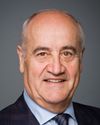Thank you very much, Mr. Chair and colleagues.
Good morning to all of you. It is always an honour for me to be here with you.
Particularly it's an honour to be here this morning with Associate Minister Fantino to discuss the supplementary estimates (C) for the year 2011-12, as well as the main estimates for 2012-13. I note for the record, Mr. Chair, this is my 24th appearance before committee since I was appointed to cabinet in 2006.
As you have already pointed out, we have a formidable team of representatives from the Department of National Defence: Mr. Matthew King, Vice-Admiral Bruce Donaldson, Mr. Kevin Lindsey, and last but not least Mr. Dan Ross. They are all here in support of this committee and the consideration of the estimates.
As was the case when I last appeared before this committee to discuss the supplementary estimates in December, we are here to answer your questions, and I thank you for the work that you do.
Mr. Chair, this has been a very busy year for the Department of National Defence and for the Canadian Forces. In the last 12 months we have successfully wrapped up the combat mission in Kandahar, transferring responsibility to our American and Afghan partners in the south.
We have established our training mission in Kabul, Herat, and Mazar-e-Sharif.
We've also participated actively in NATO's UN-sanctioned mission in Libya where Canadian airlift and frigates played a leadership role in operations. The exemplary work of Lieutenant-General Charlie Bouchard, as the campaign's overall commander, highlighted the value of Canada as we provided significant impact to these international events and efforts.
We have also been busy here at home. Over the course of just a few months we responded to requests for assistance in three separate floods and a number of forest fire evacuations. We responded to the crash of the Boeing 737 First Air Flight 6560 near Resolute. And of course, we also continued conducting our regular domestic operations—missions that keep Canadians safe—like search and rescue, sovereignty patrols in the Arctic, and surveillance as part of NORAD.
Mr. Chair, this is the kind of excellence Canadians expect from their armed forces, but such capabilities obviously come at a cost. Beginning in 2006, the Government of Canada has made the rebuilding of Canada's defence capability a cornerstone of our government's agenda. Since that time, the defence budget has grown an average of $1 billion per year. Acquisitions such as strategic airlift, land combat vehicles, and the comprehensive rebuilding of the Canadian naval fleets will contribute to a modern, effective Canadian Forces that are a source of immense pride for Canadians. I expect that you will have some questions on some ongoing procurements. I know that my colleague Minister Fantino will be pleased to take your questions.
The importance of such a force today in a turbulent world cannot be overstated, nor can the fact that the global economic situation has changed and remains fragile. But we also recognize our responsibility to carefully manage public funds, to contribute to the overall fiscal health of the entire government, and to be responsible to taxpayers.
As you know, Mr. Chair and colleagues, the global fiscal outlook has changed dramatically since 2008, when the federal government committed to returning to a balanced budget in the medium term. Like other Canadians who are tightening their belts in regard to spending in the face of the economic downturn, so too is the Department of National Defence.
Concurrently, the DND-Canadian Forces operating environment has also changed. As I mentioned, at National Defence we are returning to a lower operational tempo with the end of our combat operations in Afghanistan and the completion of the NATO mission in Libya. We are taking the opportunity to examine our structure and our processes, to integrate what we have learned in Afghanistan, and to streamline operations and make the Canadian Forces more efficient and more effective so that we get the greatest overall effort from Canada and the greatest benefits for Canadian taxpayers. This is the goal.
Mr. Chair, DND's commitment to responsible spending and sound fiscal management is manifested in those supplementary estimates (C). These identify approximately $215 million in new spending that was necessary to move forward on key initiatives. Let me refer briefly to those.
Referring to page 81 of the supplementary estimates, you will find details of the spending, which includes $151.9 million in support of the new training mission in Afghanistan, $27.3 million for the implementation of the LAV III upgrade, $14.5 million for the Arctic/offshore patrol ship project, and $4.7 million to enhance support for severely injured members of the Canadian Forces.
However, this new spending does not require any net increase in our overall funding this fiscal year. In fact, you will find, Mr. Chair, that the bottom line of page 81 identifies a net decrease of approximately $723,000 in our appropriations and spending authorities for the year 2011-12. We've been able to do this by sourcing the new spending requirement listed in supplementary estimates (C) from spending authorities already available within the defence appropriation. We have moved money with your authority.
Mr. Chair, turning now to the main estimates for the year 2012-13, our overall estimated budget requirement is $19.8 billion—just under $20 billion—which still exceeds the 2009-10 main estimates of $19.2 billion. These funds will be invested across the four pillars of the Canada First defence strategy—personnel, equipment, readiness, and infrastructure—in a measured way to ensure that DND and the Canadian Forces can carry out their important work both today and tomorrow.
The main estimates for the next year include the $333.6 million annual escalator. That is the 2% escalator on defence spending announced in the Canada First defence strategy and in our budget of 2008. It is for providing long-term and predictable funding, and I would suggest that it is one of the most important features of the Canada First defence strategy. This annual escalator clause is unprecedented in Canada's National Defence budget history.
Mr. Chair, page 245 of the main estimates also makes reference to $694.3 million in funding transfers to other departments and agencies in support of key government initiatives. I'll briefly outline them.
An amount of $305.7 million will constitute the Department of National Defence's contribution to the establishment of Shared Services Canada, an organization about which you can learn a great deal on page 312. This is essentially an effort across government departments to consolidate some of the services being provided internally, such as communications and computer services.
Mr. Chair, another $388.6 million supports the establishment of the Communications Security Establishment and Communication Security Establishment Internal Services Unit as a stand-alone agency. Again, more information can be found at page 250 concerning CSE and this new stand-alone entity.
These responsibilities continue to be carried out, albeit outside the direct National Defence budget.
You will also note the reallocation of $525 million from the Defence budget to support government efficiency exercises, as well as a number of changes that reflect the current planning context. For instance, a reduction of $121 million in requirements to support Canada's international security operations in Afghanistan. This is a direct result of the end of our combat mission in Kandahar.
We will also require $232 million less in 2012-2013 than we did in the last fiscal year for major capital equipment and infrastructure initiatives. This change will align our financial resources with the acquisition timelines for these projects.
Mr. Chair, in conclusion, when I appeared last year before this committee and before the Standing Committee on Government Operations and Estimates to discuss the 2011-12 main estimates, I spoke of the importance of balancing the needs of the Canadian Forces with the imperative of protecting Canada's fiscal health.
This imperative has not changed.
Careful budgetary management remains crucial at our department, especially following the coming to a close of the Canadian combat mission in Kandahar, including all of the readiness efforts and the sacrifice to sustain that effort.
Mr. Chair, we have lost 158 brave Canadian Forces members, and many others have paid an enormous price for the service to their country and to the international community. They are always in our thoughts and always in our planning with respect to the future well-being of those who have returned and the families who stand behind them.
Mr. Chair, our efforts have allowed us to successfully tackle our core missions for the benefit of all Canadians and within the fiscal envelope. But it is the human cost that we can never lose sight of. None of our efforts would have been possible without the exceptional dedication and skill of members of the defence team, both in and out of uniform, and I want in particular to pay tribute to their efforts today.
I thank you for your attention during these opening remarks.
Thank you to everyone.
I look forward to your questions.





